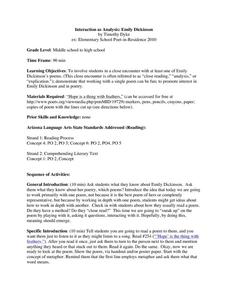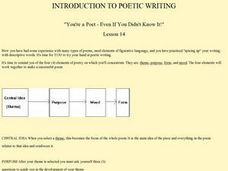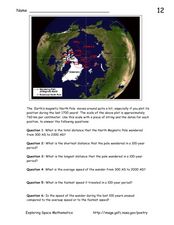Curated OER
Sonnet Explication
Students analyze close readings of poems, looking up words in the dictionary, and discussing the major parts of dictionary definitions, including word origin and parts of speech. They examine sonnets, then compare/contrast their findings.
Curated OER
The Lion, the Witch, and the Wardrobe: Bio Poem
Get to know your learners on a deeper level or invite them to step into someone else's shoes by introducing them to a bio poem. With this type of poetry, scholars will answer questions such as self-description, hopes for the future, and...
Curated OER
The Odyssey Lesson 6
"How are belief systems represented and reproduced through nature?" This essential question guides lesson 6 of this unit on The Odyssey (the rest of the unit is linked). Students first write about a scenario in which they are...
Curated OER
Shakespeare Limericks 3
While this Fun Trivia online quiz has little educational merit, the idea of writing limericks to describe Shakespeare's plays is not only fun, but also has academic value. It's worth taking a look!
Curated OER
Interaction as Analysis: Emily Dickinson
Emily Dickinson’s “Hope is a thing with feathers” is the focus of a series of activities that model for learners how close reading can lead to understanding. The whole class plays with the metaphor, groups talk about the author’s...
New York State Education Department
Comprehensive English Examination: January 2013
It's out of my control! Pupils read passages about characters in situations beyond their control. They answer comprehension questions to demonstrate understanding of their reading and answer short answer questions. Scholars complete the...
New York State Education Department
Comprehensive English Examination: June 2011
Get those pencils sharpened—it's time to see what the class knows! Using the resource, scholars complete a four-part English examination. They read passages and respond to multiple-choice comprehension questions. They also complete two...
Tayasui.com
Drawing with Carl
Who is Carl? Carl is a little monster that will help your learners draw and create in any way imaginable. Get those kids to activate creative and imaginative thinking skills with a really fun app. There are endless options that can...
Curated OER
INTRODUCTION TO POETIC WRITING
Students read about the four elements of poetry: form, theme, purpose, and mood. They are given several questions to ask themselves about each element as they begin to write their own successful poems.
Curated OER
Reading: Home on the Range
In this cowboy poetry instructional activity, students read about stories and poems in the American West. Students read the lyrics of "Home on the Range". Students answer 7 multiple choice questions.
Curated OER
No Need To Be Puzzled About Me
Fourth graders investigate acrostic poetry by researching the Internet. In this poetry writing lesson, 4th graders complete a worksheet detailing their personal activities and interests. Students view the form of an acrostic...
Curated OER
Annabel Lee
In this poems worksheet, students read a poem about Annabel Lee and complete multiple choice questions and a word search. Students complete 2 activities.
Curated OER
First Day of GT
Students discuss feelings about being teased about being a gifted student. In this feelings lesson plan, students then toss balls to each other and give responses based on questions asked.
Curated OER
My Secret War: Lesson 14
Fifth graders explore the civilian role during World War II. In this social studies lesson, 5th graders write an "I Am an American" poem from the perspective of various Americans during the war.
Curated OER
A. B. "Banjo" Paterson
In this A. B. "Banjo" Paterson online worksheet, students read three poems written by one of Australia's best know writers. Students click on several sites to answer fourteen questions about the author and his poems.
Curated OER
Forces in Motion-Science Puzzlers, Twisters & Teasers
For this physical science worksheet, students complete 6 questions about forces in motion in the form of word puzzles, poems, riddles, scrambles, and brain teasers.
Curated OER
Leaves of Grass by Walt Whitman
In this online interactive reading comprehension worksheet, learners respond to 12 multiple choice questions about Whitman's Leaves of Grass. Students may submit their answers to be scored.
Curated OER
Native American Culture
Students read a variety of Native American Literature and discuss the main idea by answering critical thinking questions about the poem. Students use context clues to understand the feeling of the Native American culture about the Earth....
Curated OER
The International Space Station
In this International Space Station worksheet, students are given the altitude changes in the space station on a graph from 2000-2004. Students answer 5 questions about the trends in the graph, the changes in altitude, the reason for the...
Curated OER
Earth's Magnetic Pole
In this Earth's magnetic pole worksheet, students use a diagram showing the changes in the magnetic pole of the Earth over time. Students use the given scale of the changes to answer 6 questions about the average speed of the magnetic...
Curated OER
Aftermath and Universal Lessons of the Holocaust
Students reflect on the information given to them during the examination of the Holocaust. In groups, they answer hard questions about what they have learned and how they could make a difference in the world today. They also analyze...
Curated OER
Magnetic Storms
In this magnetic storms and Earth's magnetic field activity, students use a bar graph showing the Kp Index for planetary variability. Students use the bar graph to answer 3 questions about the solar storms and their Kp values.
Curated OER
Cyrano de Bergerac Quiz
In this online interactive reading comprehension worksheet, students respond to 15 multiple choice questions about Rostand's Cyrano de Bergerac. Students may submit their answers to be scored.
Curated OER
Time Zones
For this time zones worksheet, students are given a map of the Earth indicating the time zones, the prime meridian and the international date line. Students answer 5 questions about solar occurrences and determine when each would be seen...























